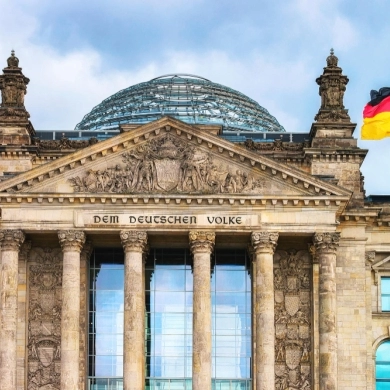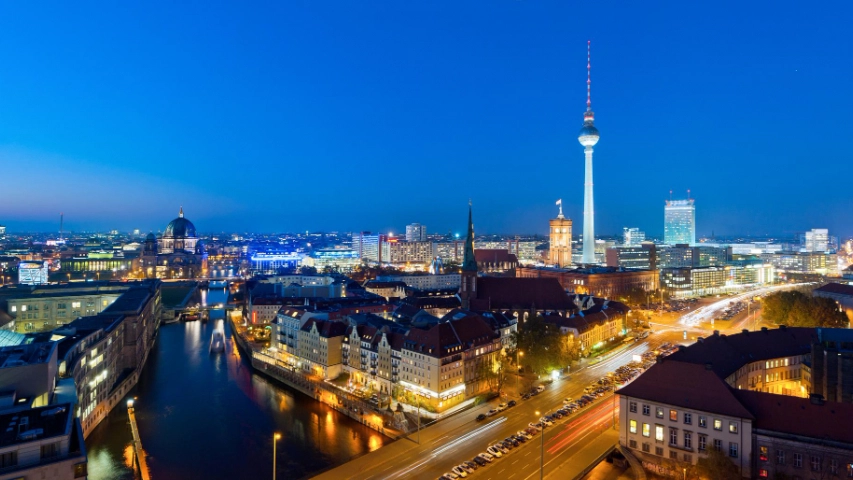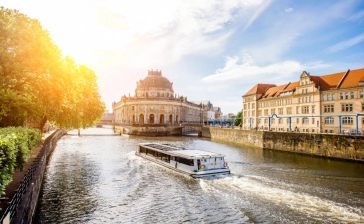Berlin is the capital of Germany, and capital of one of the 16 federated states or "Landers" or federated states of the country.
This incredible city is located in the northeast of Germany and has a population of 3.8 million people, making it the most populous city in the country.
In 2013 it was awarded by the EU as an example of an accessible city (Access City Awards), for its initiatives to improve accessibility. It is undoubtedly a very attractive destination for people with mobility problems, thanks to its wide range of leisure activities and tourist activities for people with reduced mobility.
It's worth noting that the city has made a significant effort in terms of public transportation and other services to be accessible to people with disabilities. We congratulate the city of Berlin for its efforts to make the city accessible and welcoming to people using wheelchairs
As far as tourism is concerned, we can say that the total number of visitors in 2020 and 2021 (the years most marked by restrictions) was around 10 million. In 2019 alone, before the start of the pandemic, almost 14 million people visited the German capital, with more than 34 million overnight stays.
Berlin has a wide range of museums (over 180), libraries, restaurants, nightclubs, and high-quality music events, making it a very cosmopolitan, young, and dynamic city.
We want to leave you the direct link to the tourist website of the city, since in it you can find a lot of information about tourist activities, accommodation, transport, events and other proposals accessible to PRM (They have a database called Mobidat that can be very useful).
https://www.visitberlin.de/en/wheelchair-accessible-berlin
Some interesting facts about Berlin:
- It's currency is the €uro
- His telephone prefix is (+49)
- If you belong to the European Union you do not need a passport to enter the country. If you do not belong to the European Union, you must consult the conditions of access and visa in each case.
- Its time zone is Greenwich Mean Time (GMT) +1
- Its typical dishes are Currywurst or Eisbein.
- One of the most important parties is the Oktoberfest, in which the main attraction is beer.
- Germans are usually serious and distant, but as soon as you meet them you will see that they are hospitable and friendly people.
All tourist offices in Berlin are fully accessible to people with reduced mobility. In these offices you can get all kinds of important information about the city, maps, tickets for sightseeing and events, you can also book accommodation. The staff at the tourist offices are multilingual and are always willing to help to make your stay in Berlin unforgettable.
If you visit Berlin, we recommend that you get the "Berlin Welcome Card" which, like in many other major European cities, gives you discounts on attractions, museums, and shows and includes access to public transportation.
You can get this card at any tourist information point in the city.
There are several options available, but you can choose between the basic one that costs €9 and it's valid for 72 hours, to the most complete one that has a starting price of €69 and with which you will have free access to many museums, discounts in restaurants, unlimited public transport and much more.
We leave you an interesting link where you can find much more information about the Berlin Welcome Card:
https://www.visitberlin.de/en/berlin-welcome-card
Brandenburg Airport Tourist Office:
This office is located in Terminal 1 on level E0 and is accessible to people with reduced mobility. It has multilingual staff available to assist you at all times. The office is open from Monday to Sunday from 09:00 in the morning to 21:00 at night. On New Year's Day, December 24th, 25th, 26th, and 31st, it has special hours, but it is always open until at least 6:00 p.m.
Address and contact:
- Flughafen Berlin BrandenburgWilly-Brandt-Platz 112529. Schönefeld
- Email: info@visitBerlin.de
Hauptbahnhof train station Tourist office:
This office is located in the shopping gallery of the Hauptbahnhof train station in a visible and accessible location. The staff is prepared to assist travelers in various languages and can help with many aspects of your stay in Berlin.
The office is open from Monday to Sunday from 08:00 in the morning to 21:00 at night.
On New Year's Day, December 24th, 25th, 26th, and 31st, it is open from 9:00 a.m. to 17:00 p.m.
Address and contact:
- Erdgeschoss/ Eingang Europaplatz 10557. Berlin
- Email: info@visitBerlin.de
Brandenburg Gate Tourist office:
This tourist office is located in one of the most visited landmarks in the city, making it a convenient stop for tourists in the area. Both the office and the attraction are accessible to people with mobility issues. The office is located in the south wing of the building and has staff trained to assist tourists in various languages. They can help with finding accommodation, suggesting attractions, and recommending restaurants and entertainment venues. Tourists can also purchase the Berlin Welcome Pass, find maps, and obtain tourist guides at the office.
The office is open from Monday to Sunday from 10:00 a.m. to 6:00 p.m. On New Year's Day, it is open from 10:00 a.m. to 5:00 p.m., on December 24th it is open from 10:00 a.m. to 2:00 p.m., and on December 25th and 26th it is open from 10:00 a.m. to 5:00 p.m. The office is closed to the public on December 31st.
Address and contact:
- Pariser Platz, sudliches Torhaus 10117. berlin
- Email: info@visitBerlin.de
Humboldt Forum Tourism Office:
This tourist office, like the others, is accessible and located at Portal V, accessible via Schlossplatz in the direction of Schlüterhof. In addition to providing information on accommodation, attractions, restaurants, and other activities in the city, the office also features a model of what the city looked like in 1900.
The office is open from Monday to Sunday from 10:00 a.m. to 6:00 p.m. On New Year's Day, it is open from 2:00 p.m. to 8:00 p.m., on December 24th it is closed, on December 25th and 26th it is open from 12:00 p.m. to 6:00 p.m., and on December 31st it is closed to the public.
Address and contact:
- Schloßplatz 10178. Berlin
- Email: info@visitBerlin.de
As we have already mentioned, Berlin is a very friendly city with people with mobility issues and this is also due to its public transport which is prepared to meet the needs of people with reduced mobility, starting with its airport, but also its train, metro, bus or taxi services are very well adapted.
It's worth noting that Berlin is a very flat city, and the vast majority of its sidewalks have been lowered to make it easier for people using wheelchairs or scooters to move around.
We also want to emphasize that Berlin is a very flat city and the vast majority of its sidewalks are lowered to facilitate movement on a wheelchair or scooter.
Airport:
Berlin-Brandenburg Willy Brandt Airport is 27 km from the city center and receives flights from almost everywhere in the world. The airlines that operate out of this airport include Lufthansa, Ryanair, EasyJet, and Eurowings.
For people with reduced mobility or physical or sensory impairments, Berlin Brandenburg Airport offers a free mobility service. If you are traveling to Berlin, we recommend that you inform your airline, tour operator, or travel agency of your assistance needs, preferably when booking your flight or at least 48 hours before your arrival at the airport, so that they can best serve you.
The airport is fully prepared and adapted to help people with mobility issues, with mobility service points located at the check-in counters in each terminal:
- In Terminal 1, on level E1
- In Terminal 2, on level E0
There are also call columns at the front of each terminal that you can use to communicate with the mobility service. You can also go directly to the check-in counter for your flight and inform the staff of your assistance needs. A member of the Mobility Service will be with you shortly to help you.
Please note that there may be stairs and long distances within the airport, and you may also have to use stairs if your plane is parked at a gate that requires them. If you are unable to overcome these obstacles independently, make sure to register with the Mobility Service in advance.
If you are traveling with your own wheelchair, you can check it in at the baggage counter. At this time, you will be given a Mobility Service wheelchair for your transfer from the counter to your plane seat. If you use an electric wheelchair, remember to always check it in at the baggage counter.
Airport contact:
- Twitter: @berlinairport
- Telephone: (+49) 30609160910
From the airport to the center:
Train:
Without a doubt, the best option for getting from the airport to the city center is the train, as it has stations in Terminals 1 and 2 and operates from 04:30 in the morning until 00:30 at night. The trains are fully adapted for people with mobility issues, with carriages equipped with ramps and interior space for several wheelchairs. It is advisable to request assistance from the Deutsche Bahn service, but it is not mandatory, as the trains have very good accessibility.
The "Flughafen Berlin Brandenburg – Terminal 1 and 2" train station is directly below Terminal 1, and elevators take you directly from the arrivals or departures terminal to the train platform.
The Flughafen Express trains (RE7 and RB14) run every 5-10 minutes and take about 30 minutes to reach the center of Berlin. The ticket price is €3.60, but we recommend getting the Berlin Welcome Card, which includes zones A, B, and C, to cover the journey to the airport.
If your flight arrives at Terminal 5, we recommend taking the S Bahn S9 train, which runs every 20 minutes and takes about 30 minutes to get to Alexanderplatz.
Bus:
The X7 bus is available in all 3 airport terminals, it is accessible for people in wheelchairs, but it will not drop you off in the city center, it will drop you off at the U Rudow metro station and from here you can take the metros U1, U3, U7 and in about 25 minutes you will be in the center of Berlin (Total journey is approximately 1 hour)
We recommend this option if you arrive at night (when the train does not work).
Taxi:
Taxis in Berlin are cream-coloured, making them easily recognizable. In Berlin there are about 7,000 taxis and their prices are €2 per-km but drop to €1.5 after 7 km. They will also add a surcharge of €1 per suitcase or package.
Remember that the raising of the flag is €3.9, you can pay by card or in cash.
The price of a taxi from the airport to the center is about €50 and the journey takes about 40 minutes.
We leave you the contact telephone number of some of the most important taxi companies in Berlin. All of them have vehicles adapted for people with reduced mobility.
- Taxi Berlin: (+49) 3020 20 20
- Wurfelfunk: (+49) 3021 01 01
- TaxiFunk Berlin: (+49) 3044 33 22
- Quality Taxi: (+49) 3026 300 0
Transportation within the city:
Train:
90% of the stations in Berlin and its surroundings are accessible to people with reduced mobility thanks to lifts and ramps that facilitate access.
The central station of Berlin "Hauptbahnhof" was inaugurated in 2006 and has ramps, elevators, optical signals and other facilities for people with some type of disability.
An S-Bahn station is only considered completely barrier-free if:
- It has a platform or elevator (with handrail)
- Elevators have braille buttons
- The platforms are equipped with tactile guidance system
- The signs and schedules are located in such a way that they can be read by a person in a wheelchair.
It is also important to know that
- 160 of the 168 S-Bahn stations in Berlin and Brandenburg are usually barrier-free due to their location at ground level, ramps and/or elevators. *
- 145 train stations are equipped with a platform guidance system for the blind.
- 49 stations have handrails on the stairs with Braille writing.
- There are 238 elevators in the train stations.
- There are 262 escalators in total at the stations.
The stations that do not have an elevator are:
Karl Bonhoeffer Psychiatric Clinic, Gehrensestrasse, Platform Yorckstraße S2, Nolderplatz, Marienfelde, Eichwalde, Schonfliess and Hirschgarten.
When boarding the train, it is recommended that travelers in wheelchairs get as close as possible to the driver for visibility. To locate the exact stop, travelers can look for markings on the platforms, such as blue signs with the label "Kurzzug start," as well as the destination indicators, which provide information about the length of the train.
New trains have multi-use compartments with ample space for wheelchairs, strollers, and bicycles. These compartments have service columns between the folding seats to facilitate wheelchair access and include:
- Intercom: In an emergency, contact the security center, then the video image of the compartment is transmitted.
- Blue button: Disembarkation assistance request button for wheelchair users (overflow ramp), extends the opening time of the doors at the front of the train.
- Yellow button: button for voice connection to the S-Bahn service center for questions or to report dirt in the car.
Metro:
This is one of the best ways to get around Berlin, its wagons are painted yellow and practically all of the Berlin metro stations are accessible to people with reduced mobility.
It has 9 lines, both underground and on the surface.
- U1 line: Green
- U2 Line: Red
- U3 Line: Turquoise Green
- U4 line: Yellow
- U5 Line: Brown
- U6 Line: Purple
- Line U7: Light Blue
- U8 Line: Dark Blue
- Line U9: Orange
Its schedule is from 04:00 in the morning to 01:00 in the morning, but many lines are open 24 hours a day, and their frequency at rush hour is 5 minutes, at night it is 10 minutes, and the weekends the frequency is 10 minutes and at night 15.
People with reduced mobility should sit in the first carriage so that the metro driver can easily see them.
We leave you a map of the stops and more information about it.
https://mapa-metro.com/es/Germany/Berlin/Berlin-U-Bahn-mapa.htm
Bus:
Berlin has over 300 bus lines, 40 of which are night buses, and almost all of them are accessible to people with mobility issues or using wheelchairs. The buses in Berlin cover most of the city, including tourist sites, but the metro and tram are generally faster modes of transportation.
The bus operates from 04:30 in the morning to 01:00 in the morning, and the night buses run from 00:30 to 04:30. From Monday to Friday, the bus has a frequency of between 10 and 20 minutes, while the night lines run every 30 minutes.
Taxi:
Taxis in Berlin are cream-colored and easy to identify. There are about 7,000 taxis in the city, and their prices are €2 per kilometer, dropping to €1.5 after 7 kilometers. They also charge a surcharge of €1 per suitcase or package. The base rate for hailing a taxi is €3.9, and payment can be made by card or in cash.
Several of the major taxi companies in Berlin have vehicles adapted for people with reduced mobility. Here are the contact telephone numbers for some of them:
- Taxi Berlin: (+49) 3020 20 20
- Wurfelfunk: (+49) 3021 01 01
- TaxiFunk Berlin: (+49) 3044 33 22
- Quality Taxi: (+49) 3026 300 0
Tram:
Trams are a popular mode of transportation in the eastern part of Berlin, especially during the Cold War. Most of the trams are adapted for people with reduced mobility. The tram system has 20 lines and over 400 stations, making it one of the longest systems in the world. It is convenient due to its speed and there is also a Metro Tram, which runs more frequently than the regular tram and operates all night on weekdays.
The tram runs 24 hours a day with a frequency of between 10 and 20 minutes (30 minutes at night).
Hopfinger Restaurant: https://www.bier-genuss.berlin/hopfingerbraeu-am-brandenburger-tor/
This restaurant serves traditional German and Berlin cuisine, including dishes like currywurst, as well as pasta, salads, and soups. It features tables with a central leg to allow easy access for people in wheelchairs. The restaurant also has an indoor terrace, which is a great option on nice days.
The restaurant is fully accessible, including the restrooms.
Address and contact:
- Ebertstrasse 24. 10117 Berlin
- Telephone: (+49) 3020458637
Luise Kopenick Restaurant: http://www.luise-koepenick.de/
This restaurant, located right in front of the historic town hall and between the Dahme and Spree rivers, serves delicious German food and a wide selection of wines. It's a great place to go for a drink and watch the sunset. The restaurant is open every day from 11:00 a.m. to 10:00 p.m.
The restaurant is fully accessible, including the restrooms.
Address and contact:
- Alt-Kopenick 20. 12555 Berlin.
- Telephone: (+49) 3064329777
Restaurant Baret: https://www.humboldtforum.org/de/programm/dauerrangebot/essen-und-trinken/restaurant-baret-34035/
Located on the roof of the Forum Humboldt, this restaurant is easily accessible via an elevator and offers breathtaking views of the museum island, Brandenburg Gate, Mitte district, and other landmarks. It's a perfect spot to enjoy a meal prepared by Chef Octavio Oses Bravo. The menu features vegetarian options as well as meat and fish dishes of high quality.
The restaurant is also accessible to people with mobility issues, as are the restrooms.
Address and contact:
- Schloßplatz 10178, Berlin
- Telephone: (+49) 17672894500
- Email: kontakt@baret.berlin










